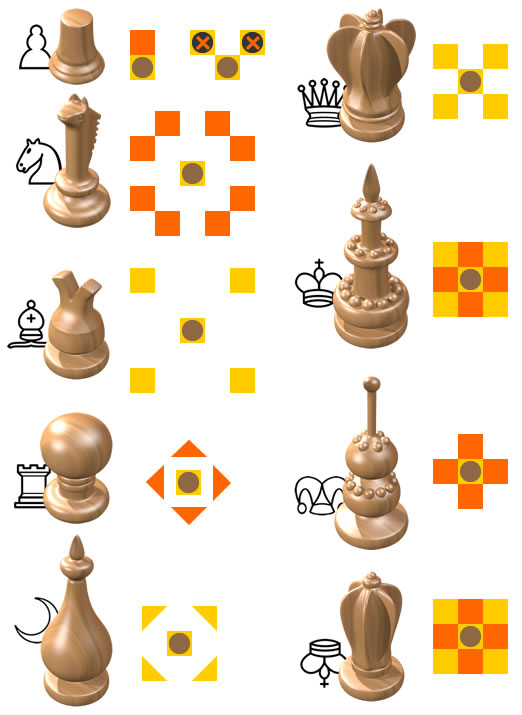Description
Courier Chess is a 12x8 board variant of chess probably created in the 12th century, Germany.
The game would have survived until the beginning of the 19th century in Germany and some neighbouring countries.
Some say Courier Chess created the modern bishop moves: unlimited diagonals. Before this the so called Medieval Bishop (Archer in Courier chess) was moving like an Alfil (Elephant): two squares diagonally, leaping the first square.
Rules
Jocly Courier Chess cheat sheet

Pieces
White and black pieces for 2D and 3D versions (from left to right):
- Pawn (12 per player)
- Knight (2 per player)
- Archer (2 per player)
- Rook (2 per player)
- Queen (1 per player)
- King (1 per player)
- Schleicher (1 per player)
- Courier (2 per player)
- Man (1 per player)

There might be expert discussions about the Courier Chess rules and we are open to players feedback. For a start we chose to implement the Wikipedia version of the rules.
The following text is extracted from Wikipedia, under Creative Commons Attribution-ShareAlike 3.0 License. For more details and references, please access the original article.
Courier Chess (or the Courier Game) is a strategy board game in the chess family. The original form probably originated in the 12th century and is known to have been played for at least six hundred years. The game was subsequently replaced by a more modern form. It pioneered the modern chess bishop (called the "courier"), and probably played a part in evolving modern chess out of Medieval Chess.
Initial setup
Courier Chess, position after obligatory starting moves

Courier Chess is played on a board of eight ranks by twelve files. Literary and artistic evidence indicate that the board was checkered from the beginning, but that there was no consistency as to which squares were dark. The more frequent practice seems to be that the square at each player's lower-right is white.
The winning objective is the same as modern chess – to checkmate the enemy king. The pieces are as follows:
- The kings start on squares of their own colour, at f1 and f8. The same as in modern chess, a king moves one step in any direction, and a player may not place his own king in check. There is no castling.
- Next to the king, on e1 and e8, stands the Rath or Mann (or counsellor or henchman), which moves the same as the king, but may be placed or left en prise (attacked by an enemy piece).
- On the other central file, at g1 and g8, stands the queen, who has the move of the fers (or firzan): one step diagonally in any direction.
- On the queen's other side, at h1 and h8, stands a piece known as the Schleich (or sneak, smuggler, spy, or fool) or Trülle (trull), sometimes depicted as a jester, moving one step orthogonally along a rank or file.
- At d1, i1, d8, and i8 stands the piece that gave the game its name: the Currier (courier) or Läufer, the runner. It moves the same as the modern chess bishop, any number of steps diagonally.
- Next, at c1, j1, c8, and j8, stands the Bischof or bishop (or "old man" or archer). It moves as the alfil (or fil), two squares diagonally, leaping the first square.
- At b1, k1, b8, and k8 stands the knight, and in the corners the rook. They move the same as their modern chess counterparts.
- The second rank for each player is filled with pawns, which, like modern chess pawns, move one step straight forward and capture one step diagonally forward. There is no initial two-step option. The original rule for pawn promotion is unknown. The standard medieval rule was that a pawn reaching the farthest rank was promoted at once to queen (fers).
- Development: Michel gutierrez (@_mig_) and Jérôme Choain (@jcfrog)
- Graphic design: Jérôme Choain (@jcfrog)
At the start of the game each player must move his rook pawns, his queen pawn, and his queen two squares forward (see top diagram). Such a two-square leap along a file was called a Freudensprung—English: "joy-leap".
Credits
Jocly implementation
For the graphics, we based our design on the Lucas van Leyden's famous painting of 1508 "Schachpartie" (or "The Chess Players") you can see below, and the very interesting work of Rick Knowlton (courierchess.com)

Source Wikipedia
